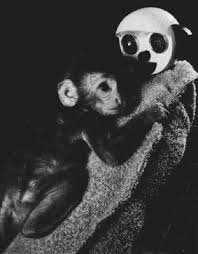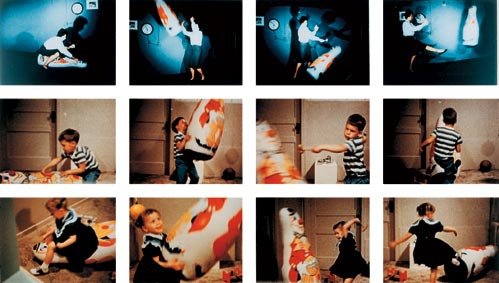It is generally accepted that psychological experiments, performed on humans or animals, contribute greatly to the understanding of our behavior. However, throughout history, some experimenters have gone too far with their studies, overlooking all the ethical guidelines. Here is a list of 19 such experiments, which should have been stopped immediately, because they only caused pain to participants.
The Monster Study
In order to prove that stuttering is not biologically-based, Wendell Johnson carried out an experiment on normal-speaking orphan children. For 6 months, the first group of children was praised for speech fluency, whereas in the second group, children were told that they had stuttering problems and abnormal speech. Consequently, due to emotional traumatization, children in the second group actually developed speech problems, that remained there for good.Stanford Prison Experiment
Professor Zimbardo created a simulation of a prison in the basement of Stanford University, wanting to determine how situational factors influence people’s behavior. Participants, who were students, were divided into prisoners and prison guards and their behavior was observed. Very soon, both groups were conforming to their roles. The guards started harassing and insulting the prisoners, who became increasingly submissive. In short time, the situation went out of control, with the guards dehumanizing the prisoners, who started screaming “Let me out of this place!” and crying. Some of the prisoners were released. On the 6th day, the experiment was stopped.

Milgram Experiment
Milgram wanted to test how far people can go in complying with authority. The Participants were given the role of a “teacher” and a pseudoparticipant was a “learner”. The job of the teacher was to check whether the learner has learnt pairs of words, and if not, to give him an electric shock. If the teacher refused, the experimenter gave him orders to continue with the shock therapy. While listening to the recorded screams of the learners, the teachers showed signs of extreme tension and distress.

Little Albert
Inspired by classical conditioning, Watson wanted to check whether humans, in this case baby Albert, could be conditioned to develop phobias. When a white rat (stimulus), accompanied with loud, frightening noise was being presented to Albert, for 7 weeks, he would burst into tears. After this time, when Albert just saw the rat, he immediately started crying. The Hypothesis that classical conditioning can create a phobia was confirmed, but the experiment is still considered highly immoral, because it inflicted serious psychological harm to an 11-months-old infant.

Blue versus Brown Eyes
As an exercise intended to change what whites thought about racism, Jane Elliot decided to divide her students into two groups: blue-eyed and brown-eyed. She said that blue-eyed children were smarter and constantly praised them, which consequently led to the blue-eyed group putting down the brown-eyed group. When the roles changed, the same results were shown. Although the kids learnt what racism looked like, they had suffered discrimination, insults, and even physical harm, during the exercise.Effects of Sleep Deprivation
In 1895, under the supervision of Iowa University scientists, three men stayed awake for 90 hours. After the second night, they started hallucinating. After 90 hours, they fell asleep so deeply that not even electric shocks could disturb them.Aversion Project
This project of South Africa during the apartheid refers to the human rights abuse of the LGBT population. Namely, lesbians and gays were submitted to sex-reorientations, done by psychiatrists and doctors. Some of the methods used were: aversion shock therapy, hormone treatment, going as far as chemical castrations and even sex-change operation. All these unethical experiments are by far the most horrific human rights violations of the LBGT population.
David Reimer: The Circumcision That Went Wrong
When David Reimer, an 8-months-old baby, was brought to be circumcised, his penis was accidentally burned off. Psychologist Money thought it best to simply change the sex of the baby, and gave David, now Brenda, hormonal supplements. However, this solution was far from success. Brenda exhibited typical male behavior. After being told that “she” was originally a “he”, Brenda decided to stop taking the female hormone estrogen and to reconstruct a penis. This struggle with gender identity, followed by deep psychological distress, was terminated by David’s suicide, at the age of 38.MK-ULTRA
During the 1950s and 1960s, CIA performed some unethical experiments, in the field of mind control. The name of these studies was MK-ULTRA. One of the participants was Theodore Kaczynski, the “Unabomber”. He was a sophomore at Harvard, when he was allocated to the experiment, in which he went through a series of “vehement, sweeping, and personally abusive” treatments. It is possible that this experiment “programmed” him to become a future terrorist, making and throwing bombs.

Study on Schizophrenia at the University of California
In this study, usually referred to as the U.C.L.A. study, schizophrenics were required to stop taking medications and check whether this would do them good. However, 23 of 50 patients suffered severe relapses, and the symptoms worsened with every recurrence. One of the participants, Antonio LaMadrid jumped from a rooftop, and another one, Gregory Aller, dropped out of college and wanted to kill his parents.The Third Wave
Can a democratic society become indoctrinated by the fascist movement? This is what the Third Wave Experiment was meant to explore. A class of high-school students was separated into two groups, with the first one considered prestigious. The members of this group soon started ostracizing and discriminating the out-group members, and this continued even outside of the classroom. The inferior group of the class experienced great psychological distress.Shock Therapy for Children
Psychiatrist Lauretta Bender gave electric shocks to 98 children, in order to cure them of what she called “childhood schizophrenia”. She also gave them LSD and psilocybin. There were insinuations that she was funded by the MK-ULTRA project.Harlow’s Monkeys
Harlow is infamous for causing pain to animals. He was studying the effects of social isolation and lack of maternal love on the later development of monkeys. For the purpose of the experiment, he held the monkeys in a tiny and black confinement, called “Pit of Despair”, for up to a year! When the monkeys left the pits, they were severely distressed, constantly rocking. The male monkeys couldn’t mate anymore, and the female ones couldn’t nurse their offspring.

Effects of Alcohol on Dogs
Effects of drugs are usually tested on animals, as it would be unethical to test them on humans. However, animals too, suffer a great deal in these experiments. In 1938, for example, dogs were used to examine the effects of severe alcoholism. When they stopped taking alcohol, most of the dogs died.Monkeys on Drugs
In this experiment, monkeys were injected with numerous drugs, in order to test the effects. Later, the monkeys were even taught how to self-inject these drugs. The consequences were horrific: some monkeys broke their arms and legs by trying to escape, some ripped off their fingers and coats. They were certainly having hallucinations. Those with cocaine and morphine injections died within 2 weeks.
Facial Expression Study
Although Landis’s aim was to see if different emotions create different facial expressions, the experiment ended with lots of beheaded rats. Namely, the final part of the experiment was to see the death of animals, and the participants were asked to behead the rats. If they couldn’t do it, then Landis did it instead, for the purpose of seeing the expression of disgust.Bobo Doll Experiment
In order to check his social learning theory in practice, Albert Bandura decided to carry out an experiment, in which a group of children would watch a man playing aggressively with the Bobo doll. The non-aggressive group was introduced to a model who only played with the doll, without showing any violent behavior. After this period of observing the model, the children were put in a cubicle with lots of toys, however, they were not allowed to play with them. This had to trigger anger in the children (thus causing them distress, which is unethical in research), and, as expected, those who were observing the aggressive model, now exhibited the same behavior: they were punching and kicking the Bobo doll in the room and showing all other kinds of aggressive behavior. Although there was a debriefing at the end of the study, the children in the aggressive group might have gone on with this behavior.

The Broken Toy Experiment
In order to understand how preschool children experience guilt, psychologists at the University of Iowa carried out the following experiment: adults gave a toy to children, explaining that the toy was very special and personal. However, as soon as a child started playing with it, it was set up to break. When this happened, an adult would say “Oh my” and stare at the child for a whole minute. This part of the experiment was supposed to teach children the concept of time dilation, namely, that when feeling guilty, one minute felt for them like an hour. Undeniably, this traumatized the kids and that makes the whole experiment unethical.Babies Crawling Off a Cliff
Cornel University psychologists were amazed at the fact that babies never crawled off the edge of things, when this could result in injury, although they did not have any experience of the consequence itself. So, they built a “visual cliff”, made of glass, so that if a baby was convinced to step from boards to the “visual cliff”, this looked like an abyss. Psychologists had the mothers of the babies try to tempt them to go across the boards. This was great distress for the babies, who started crying and looking in disbelief, not being able to express their confusion and distrust. Their own mothers were persuading them to do something that could lead to certain death!
References
http://www.simplypsychology.org/bobo-doll.html
https://salmamt.wordpress.com/2014/02/21/57/
https://salmamt.wordpress.com/2014/02/21/57/
http://www.simplypsychology.org/zimbardo.html
http://www.simplypsychology.org/milgram.html
http://www.simplypsychology.org/classical-conditioning.html
http://www.openculture.com/2015/01/the-little-albert-experiment.html
http://www.todayifoundout.com/index.php/2013/07/jane-elliot-and-the-blue-eyed-children-experiment/
https://vanwinkles.com/six-bizarre-experiments-that-pushed-the-boundaries-of-sleep-medicine
http://www.ncbi.nlm.nih.gov/pmc/articles/PMC535952/
http://www.bbc.co.uk/science/horizon/2000/boyturnedgirl.shtml
http://mentalfloss.com/article/62564/how-extreme-psychological-study-may-have-affected-young-ted-kaczynski
http://www.ncbi.nlm.nih.gov/pmc/articles/PMC2632194/
http://www.paloaltoonline.com/news_features/centennial/1960SC.php
http://www.breggin.com/ECT/ShockTrtmntChrnlgyPsychtrcAbs.pdf
http://www.simplypsychology.org/attachment.html
http://onlinelibrary.wiley.com/doi/10.1111/j.1476-5381.1946.tb00026.x/pdf
http://dianabenovapsych.blogspot.rs/2012/09/monkey-drug-trials-unethical-study.html
http://www.madsciencemuseum.com/msm/pl/facial_expressions_while_decapitating_a_rat
http://m.koreatimes.com/article/546852
http://www.psych.nyu.edu/adolph/publications/Adolph%20KE%20%20Kretch%20KS-Infants%20on%20the%20Edge%20Beyond%20the%20Visual%20Cliff.pdf
Out of these, the one that I remember hearing about was the Milgram Experiment. That is especially shocking.
Downvoting a post can decrease pending rewards and make it less visible. Common reasons:
Submit
Yes, that one is thought-provoking.
Downvoting a post can decrease pending rewards and make it less visible. Common reasons:
Submit
Одлична компилација, тако да се не мора тражити на различитим местима, @tina64. Хвала!
Downvoting a post can decrease pending rewards and make it less visible. Common reasons:
Submit
Drago mi je da ti se svidelo :)
Downvoting a post can decrease pending rewards and make it less visible. Common reasons:
Submit
Congratulations @tina64! You have completed the following achievement on the Steem blockchain and have been rewarded with new badge(s) :
You can view your badges on your Steem Board and compare to others on the Steem Ranking
If you no longer want to receive notifications, reply to this comment with the word
STOPDo not miss the last post from @steemitboard:
Vote for @Steemitboard as a witness to get one more award and increased upvotes!
Downvoting a post can decrease pending rewards and make it less visible. Common reasons:
Submit
Fantastic article, thanks for sharing :)
Downvoting a post can decrease pending rewards and make it less visible. Common reasons:
Submit
Welcome, stay tuned :)
Downvoting a post can decrease pending rewards and make it less visible. Common reasons:
Submit
The Monster Study reveals how sticks and bones may break my bones and yet word may in fact hurt me.
Downvoting a post can decrease pending rewards and make it less visible. Common reasons:
Submit
This post has been voted on by the SteemSTEM curation team and voting trail. It is elligible for support from @minnowbooster.
If you appreciate the work we are doing, then consider supporting our witness @stem.witness!
For additional information please join us on the SteemSTEM discord and to get to know the rest of the community!
Please consider using the steemstem.io app and/or including @steemstem in the list of beneficiaries of this post. This could yield a stronger support from SteemSTEM.
Downvoting a post can decrease pending rewards and make it less visible. Common reasons:
Submit